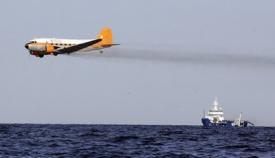 |
| So far, 715,000 gallons of Corexit 9500 dispersant has been applied since the April 20 explosion of the Deepwater Horizon. (Patrick Semansky) |
|
Oil washes ashore on 50 miles of Louisiana shoreline as tensions mount over how to treat the spill in the Gulf of Mexico.
BP has rebuffed demands from government officials and
environmentalists to use a less-toxic dispersant to break up the oil
from its massive offshore spill, saying that the chemical product it is
now using continues to be "the best option for subsea application."
On
Thursday, the U.S. Environmental Protection Agency gave the
London-based company 72 hours to replace the dispersant Corexit 9500 or
to describe in detail why other dispersants fail to meet environmental
standards.
The agency on Saturday released a 12-page document
from BP, representing only a portion of the company's full response.
Along with several dispersant manufacturers, BP claimed that releasing
its full evaluation of alternatives would violate its legal right to
keep confidential business information private.
But in a strongly
worded retort, the EPA said that it was "evaluating all legal options"
to force BP to release the remaining information "so Americans can get
a full picture of the potential environmental impact of these
alternative dispersants."
So far, 715,000 gallons of dispersant
has been applied since the April 20 explosion of the Deepwater Horizon
rig, mostly on the spill's surface. The chemical has also been released
near the leaking pipe on the seafloor.
Government officials have
justified both uses, saying that if oil reaches the shore, it would do
more environmental harm than if it were dispersed off the coast.
Dispersants
break oil into droplets that decompose more quickly. But scientists
worry that extensive use of the chemicals in the BP spill is increasing
marine life's exposure to the toxins in oil.
"While the
dispersant BP has been using is on the agency's approved list, BP is
using this dispersant in unprecedented volumes and, last week, began
using it underwater at the source of the leak - a procedure that has
never been tried before," the EPA noted last week, acknowledging that
"much is unknown about the underwater use of dispersants."
In the
company's May 20 letter to the EPA and the Coast Guard, responding to
the EPA's directive, BP operations chief Doug Suttles wrote that only
five products on the EPA's approved list meet the agency's toxicity
criteria. And only one, besides Corexit, is available in sufficient
quantities in the next 10 to 14 days, it said.
But that
alternative product, Sea Brat #4, according to BP, contains a chemical
that could degrade into an endocrine disruptor, a substance that
creates hormonal changes in living creatures, and could persist in the
environment for years.
As the tensions over how to treat the
spill escalated, reddish-brown washes of oil, 2 inches thick in places,
soiled Louisiana beaches. Hundreds of workers scooped up gooey piles of
sand and stuffed them into plastic bags.
"It is worse today than
on the past two days," said Darren Smith, 43, sweating from his work
raking sand at a wildlife refuge on Elmer's Island. "There's definitely
more oil, and it's just going to keep coming."
No booms protected
the Elmer's Island beach because the National Guard had focused on
building dams to divert oil from the wetlands behind the beach.
A
few miles away at Port Fourchon, plastic barriers that looked like
pompoms were strung together along the beach but did a poor job of
keeping out the oil. More than 50 miles of Louisiana shoreline has been
contaminated so far.
Los Angeles Times

